The 1952 wheat penny or Lincoln penny is a one-cent coin the United States Government issued in 1952. It is part of the Lincoln penny series that started in 1909. As an old coin, you might wonder how much the 1952 wheat penny would be worth today. What is its composition, historical background, and design?
These are the questions we’ll answer today. Read on to learn more.
What Is the 1952 Lincoln Wheat Penny Made Of?
The 1952 Lincoln wheat penny is made of 95% copper and 5% tin and zinc. This is the composition of the Lincoln penny from 1909 to 1982, except for 1943, when it was made with zinc-plated steel. Then from 1982 to the present day, the Lincoln penny was made with 97.5% zinc and 2.5% copper.
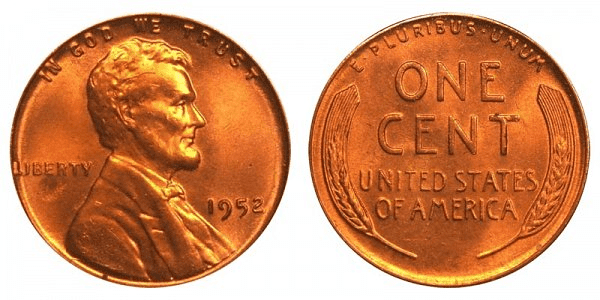
Regarding design, the obverse (head) features an image of Abraham Lincoln, probably the most popular and loved president of the United States. Victor David Brenner designed the obverse and the coin’s reverse, which you will learn more about later.
The inscriptions on the obverse side of the coin are as follows:
- IN GOD WE TRUST
- LIBERTY
- 1952
The reverse (tail) shows two stalks of wheat, which inspires the name “wheat pennies.” The design was used from 1909 to 1958. So, in just about six years, the wheat pennies would be discontinued to make way for the Lincoln Memorial as the design for the reverse.
The specifications of the 1952 Lincoln wheat penny include the following:
- Value – 1 cent
- Weight – 3.11 grams
- Edge – plain
- Diameter – 19 millimeters
There was great public interest when the new Lincoln wheat penny was released in 1952. The Lincoln penny was the first US coin with a president’s image on it that was widely circulated.
1952 Lincoln Wheat Penny Varieties
The 1952 Lincoln wheat penny is part of the Lincoln one-cent series popular among coin collectors. In 1952, there were four varieties that the US Mint released.
Here’s a quick look at the varieties as well as their mintage:
| Variety | Mint Location | Mintage |
| 1952 D Wheat Penny | Denver | 746,130,000 |
| 1952 P Wheat Penny | Philadelphia | 186,775,000 |
| 1952 P Proof Wheat Penny | Philadelphia | 81,980 |
| 1952 S Wheat Penny | San Francisco | 137,800,004 |
| Total | 1,070,786,984 |
The wheat penny is the smallest US coin in terms of value. Thus, the US Mint can produce more than a billion of them. This was true in 1952.
You can learn more about the 1952 wheat pennies below.
1952 D Lincoln Wheat Penny
Year of minting: 1952
Mint Mark: D
Place of minting: Denver
Quantity produced: 746,130,000
Face Value: $0.01 (one cent)
Price: $0.01 to $0.25 (circulated condition)
Mass: 3.11 grams
Edge: Plain
Designer: Victor David Brenner
Composition: 95% Copper, 5% Tin and Zinc
Diameter: 19.00 mm

The Denver Mint produced over 746 thousand pennies in 1952, making it the most abundant variety for that given year. This mint is well known for producing high-quality pennies, evidenced in the many examples of fully red gem pennies from the mint.
1952 P Lincoln Wheat Penny
Year of minting: 1952
Mint Mark: none
Place of minting: Philadelphia
Quantity produced: 186,775,000
Face Value: $0.01 (one cent)
Price: $0.01 to $0.35 (circulated condition)
Mass: 3.11 grams
Edge: Plain
Designer: Victor David Brenner
Composition: 95% Copper, 5% Tin and Zinc
Diameter: 19.00 mm
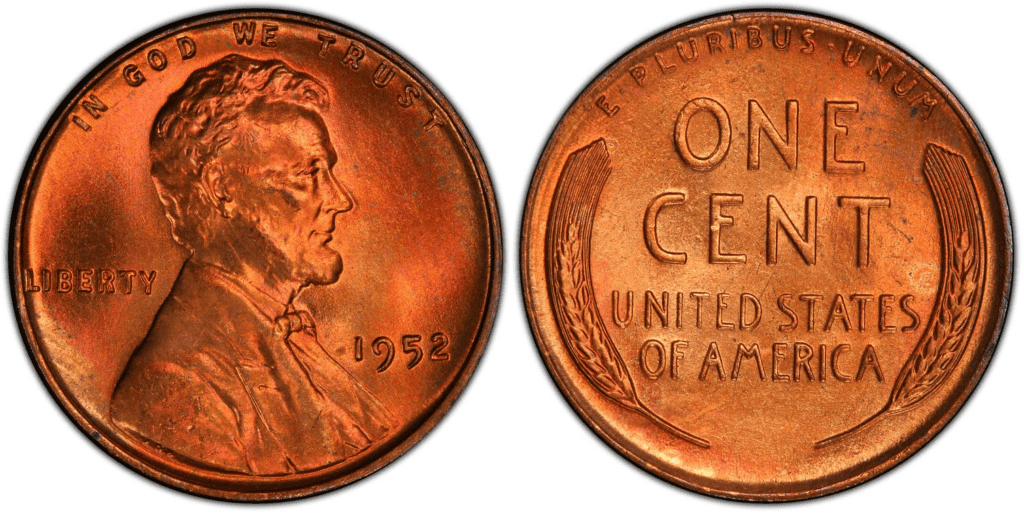
In 1952, the Philadelphia Mint produced more than 186 thousand pennies, about a hundred thousand lower than in 1951 and 1953. The 1952 P wheat pennies don’t have mint marks. Moreover, most pennies from the Philadelphia Mint come with light staining and spotting.
1952 Proof Lincoln Wheat Penny
Year of minting: 1952
Mint Mark: none
Place of minting: Philadelphia
Quantity produced: 81,980
Face Value: $0.01 (one cent)
Price: $17 or more (uncirculated condition)
Mass: 3.11 grams
Edge: Plain
Designer: Victor David Brenner
Composition: 95% Copper, 5% Tin and Zinc
Diameter: 19.00 mm
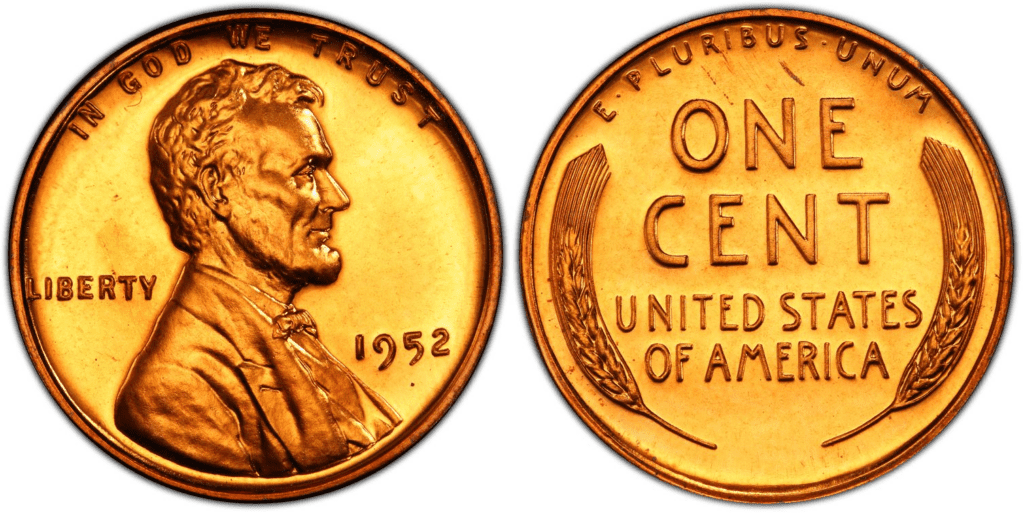
The Philadelphia Mint also produced beautiful proof penny coins in 1952. What’s interesting is that the quantity increased as more and more people got interested in proof coins. For example, in 1950 and 1951, only about 51 to 57 thousand proof coins were produced. Then, it suddenly jumped to 81,980 in 1952.
1952 S Lincoln Wheat Penny
Year of minting: 1952
Mint Mark: S
Place of minting: San Francisco
Quantity produced: 137,800,004
Face Value: $0.01 (one cent)
Price: $0.01 to $0.35 (circulated condition)
Mass: 3.11 grams
Edge: Plain
Designer: Victor David Brenner
Composition: 95% Copper, 5% Tin and Zinc
Diameter: 19.00 mm

The 1952 S wheat pennies are quite common in higher grades. However, the main issue is that the San Francisco Mint uses repolished or refinished dies. While this gives the coin a beautiful look, the engraved elements can be shallow and may lack details.
List Of 1952 Lincoln Wheat Penny Errors
The US Mint produced more than a billion 1952 Lincoln wheat penny. So, it is unsurprising to note that some coins were produced with errors. Here are some examples:
Off-center strike
The off-center strike error happens when the die strikes the planchet at the wrong angle. This might be caused by the misalignment of the die and planchet due to a loose die collar.
Here’s an example of a 1952 wheat penny with an off-center strike error:
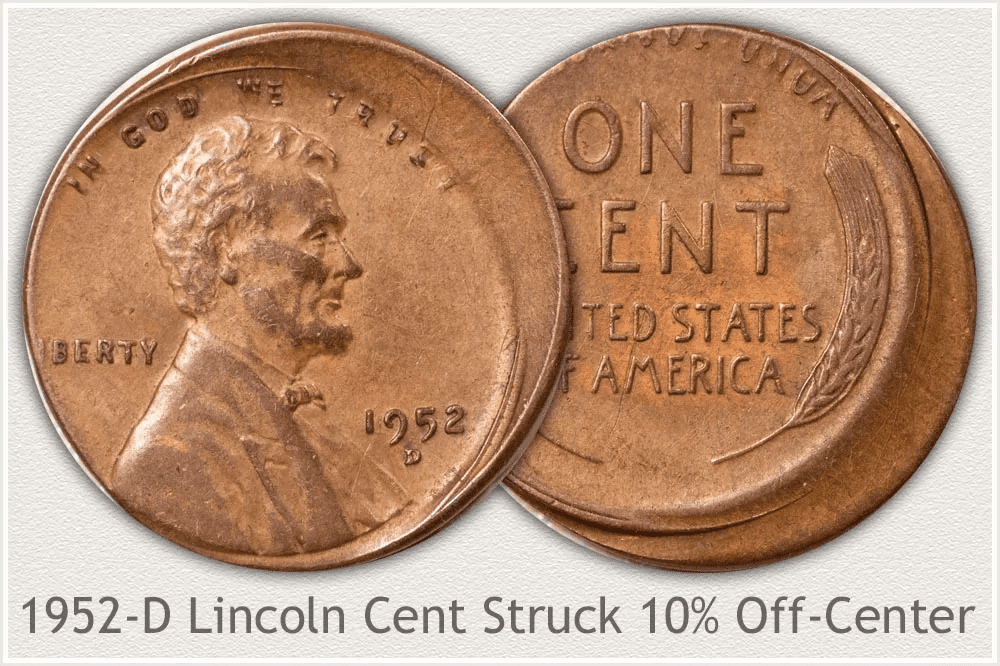
Clipped planchet
Sometimes, the error happens way before the planchet is struck. For example, the blank coin wasn’t cut properly, and this can cause the coin to have a clipped or folded portion.
Here’s what a 1952 wheat penny with a clipped planchet looks like:
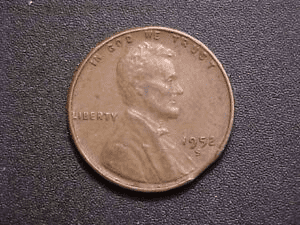
Die crack
The die strikes planchets multiple times each day. Over time, the die can crack due to wear and tear. When this happens, the cracked portion of the die is also engraved into the planchet. How the die crack error appears on a coin may depend on the extent of the die crack.
Here’s an example of a 1952 wheat penny with a die crack error:
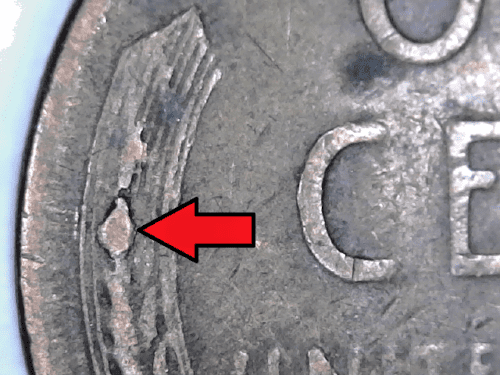
Lamination error
The 1952 penny is made of copper, tin, and zinc. These metals mix well. However, there are times when a foreign material gets in the mix. Once the blank coin cools down, the foreign material separates from the planchet, leaving the coin’s surface to look peeled or crusted.
Here’s an example of a 1952 penny with a lamination error:
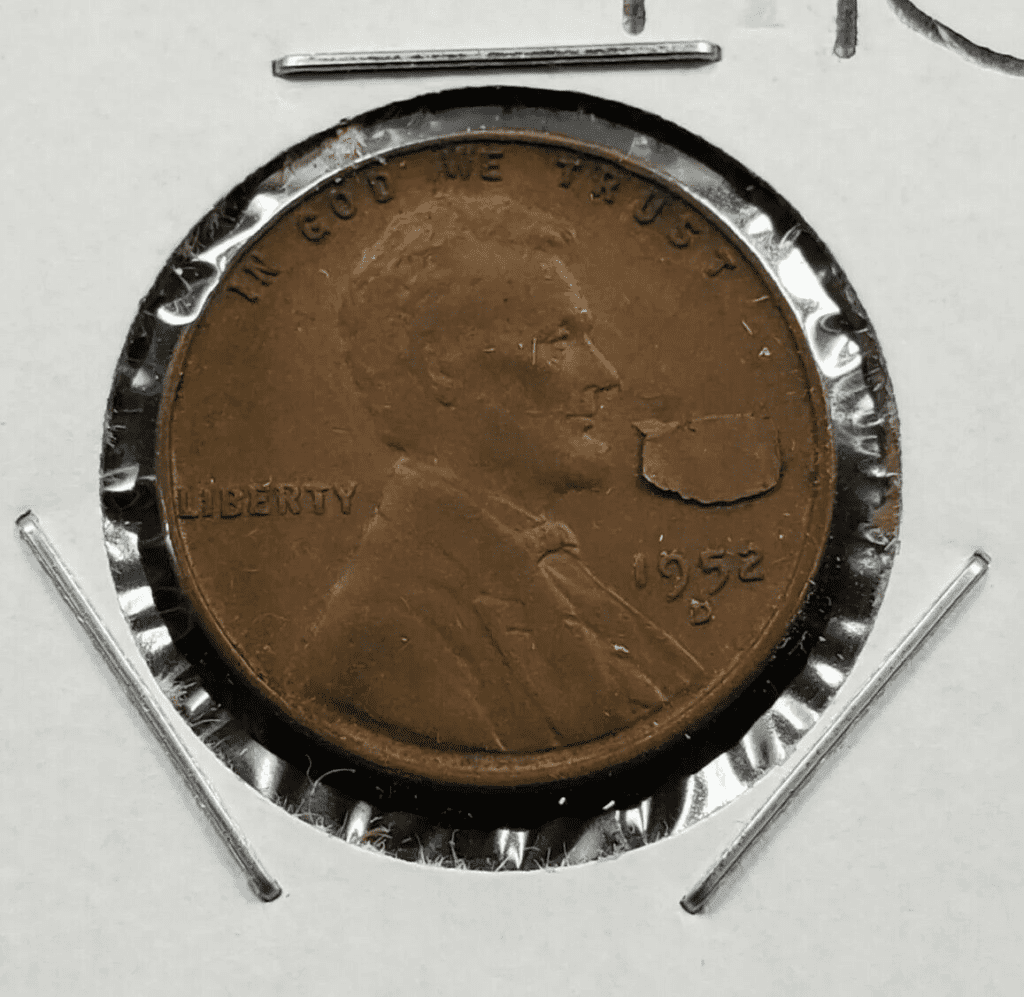
How Much Is The 1952 Lincoln Wheat Penny Worth Today?
The Lincoln penny struck in 1952 has a face value of 1 cent. Its melt value is a little higher at $0.0269. Uncirculated 1952 pennies might be just around $0.15 to $0.35.
Judging by these numbers, the 1952 Lincoln wheat penny seems not worth that much. However, this should not fool you because 1952 wheat pennies were sold for several hundred and thousands of dollars.
Here’s a table of auction records for each variety to help you better appreciate the value of the 1952 Wheat penny:
| Coin | Condition | Grade | Sold date | Sold by | Value |
| 1952 Proof Wheat Penny | Superb Gem Uncirculated – Deep Cameo | PR 68 | September 2, 2021 | Legend Rare Coin Auctions | $64,625 |
| 1952 P Wheat Penny | Superb Gem Uncirculated – Red | MS 67 | November 29, 2007 | David Lawrence RC | $9,775 |
| 1952 S Wheat Penny | Superb Gem Uncirculated – Red | MS 67+ | November 6, 2014 | Heritage Auctions | $4,113 |
| 1952 D Wheat Penny | Superb Gem Uncirculated – Red | MS 67+ | August 10, 2016 | Heritage Auctions | $2,233 |
How Does The Grading System Work?
The 1952 wheat penny is graded based on appearance, luster, attractiveness, color, and strike.
Professional numismatists joined in the 1970s and established CoinGrading standards, known as the Sheldon Scale. These numismatists now assign grades at key places on the seventy-point scale, using the most regularly utilized numeric points in conjunction with the original adjective grade. The following are the most common coin grades:
- (P-1) Poor – Indistinguishable and probably damaged; if used, must have a date and mintmark; otherwise, rather battered.
- (FR-2) Fair – Nearly smooth, but without the damage that a coin graded Poor often possesses. The coin must have enough detail to be identified.
- (G-4) Fair – Inscriptions have merged into the rims in some areas, and important elements have been mostly erased.
- (VG-8) Very Good- A little weathered, but all primary design elements are visible, albeit faintly. There is little, if any, central detail left.
- (F-12) Good – The item is very worn, yet the wear is even, and the overall design details stand out clearly. Rims are almost completely isolated from the field.
- (VF-20) Very Fine – Moderately weathered, with some finer features still visible. The motto or all letters of LIBERTY are readable. Both sides of the coin have entire rims separated from the field.
- (EF-40) Extremely Fine – Gently used; all gadgets are visible, and the most important ones are bold. The finer details are bold and clear; however, light wear may be seen.
- (AU-50) Uncirculated – Slight evidence of wear on the coin’s design’s high points; it may have contact marks; eye appeal should be adequate.
- (AU-58) Uncirculated Choice – Slight traces of wear, no severe contact marks, almost full mint shine, and great eye appeal.
- (MS-60) Mint State Basal – Strictly uncirculated; no indication of wear on the coin’s highest points, but an unsightly coin with reduced luster, visible contact marks, hairlines, and other flaws.
- (MS-63) Mint State Acceptable – Uncirculated, but with contact scratches and nicks, little reduced shine, but otherwise appealing appearance. The strike is weak to average.
- (MS-65) Mint State Choice – Uncirculated with great mint shine, little contact blemishes, and exceptional eye appeal. The strike is unusually severe.
- (MS-68) Mint State Premium Quality – Uncirculated with superb luster, no obvious contact marks to the naked eye, and exceptional eye appeal. The strike is quick and appealing.
- (MS-69) Almost Perfect Mint State – Uncirculated with perfect brilliance, a sharp and appealing strike, and extremely good eye appeal. A near-perfect coin with minor imperfections in the planchet, strike, and contact markings (seen only under 8x magnification).
- (MS-70) Mint State Perfect – Under 8x magnification, no tiny imperfections are discernible; the strike is crisp, and the coin is perfectly centered on a beautiful planchet. Rarely seen on a coin, this coin is bright and whole, with original luster and exceptional eye appeal.
Where To Buy Or Sell 1952 Lincoln Wheat Penny?
The 1952 Lincoln pennies are available in coin shops, antique stores, and pawnshops. Some 1952 Lincoln pennies could be available in auction houses. Historically, some of the most expensive and rarest coins are sold in auctions.
Moreover, you can also go to the Internet to find your needed coin. There are numerous websites online that could help. For example, you can go to Amazon, eBay, Etsy, JM Bullion, and USA Coin Appraisers.
FAQs
Where is the mint mark on a 1952 wheat penny?
The mint mark on a 1952 wheat penny is found on the coin’s obverse side. You should see it under the year of minting, which in this case, 1952. Mint marks could be S or D.
Is a 1952 D wheat penny rare?
The 1952 D wheat penny isn’t rare. There were more than 740 thousand pennies released from the Denver Mint. However, a 1952 D wheat penny with rare attributes combined with top-notch condition can be considered rare.
How much is a 1952 wheat penny with no mint mark?
The 1952 wheat penny with no mint mark can be as valuable as its face value. However, if your 1952 P wheat penny is in great condition and received a high grade, then it can dramatically increase in value. For example, in November 2007, a 1952 Lincoln penny with no mint mark was sold for $9,775.
